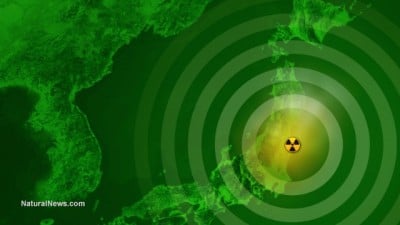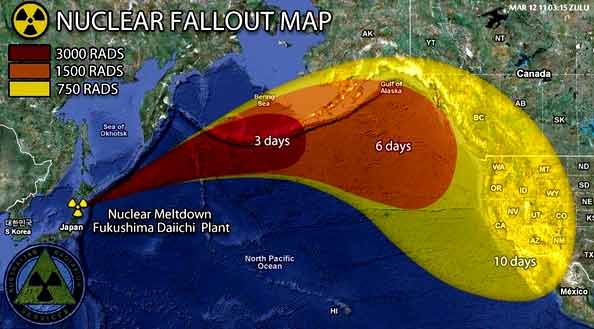TEPCO Plans Massive Release of Radioactive Plutonium into the Pacific Ocean: Fish Near Fukushima Contained Radioactive Cesium 180 Times Over Japan’s Limit
The fish was caught near a drainage outlet where water from melted nuclear reactors flows—some of the same water that is to be treated and released from the power plant starting next month.

All Global Research articles can be read in 51 languages by activating the Translate Website button below the author’s name.
To receive Global Research’s Daily Newsletter (selected articles), click here.
Click the share button above to email/forward this article to your friends and colleagues. Follow us on Instagram and Twitter and subscribe to our Telegram Channel. Feel free to repost and share widely Global Research articles.
***
Introductory Note
The World is at a critical crossroads. The Fukushima disaster in Japan has brought to the forefront the dangers of Worldwide nuclear radiation.
The crisis in Japan has been described as “a nuclear war without a war”. In the words of renowned novelist Haruki Murakami:
“This time no one dropped a bomb on us … We set the stage, we committed the crime with our own hands, we are destroying our own lands, and we are destroying our own lives.”
More than 12 years later, the evidence amply confirms that the Fukushima disaster has by no means been resolved.
“Unimaginable” levels of radiation still prevail. In the words of Dr. Helen Caldicott, “one millionth of a gram of plutonium, if inhaled can cause cancer”.
Hazardous radioactive elements being released in the sea and air around Fukushima accumulate at each step of various food chains (for example, into algae, crustaceans, small fish, bigger fish, then humans; or soil, grass, cow’s meat and milk, then humans). Entering the body, these elements – called internal emitters – migrate to specific organs such as the thyroid, liver, bone, and brain, continuously irradiating small volumes of cells with high doses of alpha, beta and/or gamma radiation, and over many years often induce cancer”. (Helen Caldicott, Fukushima: Nuclear Apologists Play Shoot the Messenger on Radiation, The Age, April 26, 2011)
The Fukushima disaster of March 2011 resulted in 16,000 deaths, causing some 165,000 people to flee their homes in the Fukushima area.
Both the Japanese and Western media have downplayed the impacts of nuclear radiation which has spread to vast areas in Northern Japan, not to mention the contamination of the food chain.
The continued dumping of highly radioactive water into the Pacific Ocean, which is now envisaged by TEPCO (with the tacit endorsement of of the UN’s International Atomic Energy Agency (IAEA)) constitutes a potential trigger to a process of global radioactive contamination. In recent developments, TEPCO is planning a release of “1.3 million tons of treated wastewater.
Amply documented the Tokyo Electric Power Company (TEPCO) has been involved in a coverup. And so has the Japanese government. The Abe government had casually pointed to “harmful rumors”. The present government’s stance remains notoriously ambiguous. Already in 2021, TEPCO acknowledged that the decommissioning of the Fukushima facility could last until 2051.
The Worldwide public health impacts which includes the contamination of the Pacific Ocean extending to the Western Hemisphere are incalculable.
The crisis in Japan has also brought into the open the unspoken relationship between nuclear energy and nuclear war.
Nuclear energy is not a civilian economic activity. It is an appendage of the nuclear weapons industry which is controlled by the so-called defense contractors. The powerful corporate interests behind nuclear energy and nuclear weapons overlap.
Michel Chossudovsky, July 25, 2023
Below is the incisive and carefully documented article by Julia Conley
***
With the Tokyo Electric Power Company planning to begin a release of 1.3 million tonnes of treated wastewater from the former Fukushima Daiichi nuclear power plant in Japan next month, reports of radioactive fish in the area have raised alarm in recent years—and new reporting on Sunday revealed that the problem is far from mitigated, prompting questions about how dangerous the company’s plan will be for the public.
The plant operator, known as TEPCO, analyzed a black rockfish in May that was found to contain levels of radioactive cesium that were 180 times over Japan’s regulatory limit, The Guardian reported.
The fish was caught near drainage outlets at the plant, where three nuclear reactors melted down in March 2011 during a tsunami.
Rainwater from the areas surrounding the reactors flows into the area where the fish was caught.
The high level of cesium—which, depending on the level of exposure, can cause nausea, vomiting, diarrhea, bleeding, coma, and death in people who eat contaminated food—was discovered as TEPCO prepares to begin the discharge of treated wastewater which has been used to cool fuel from the melted reactors. The wastewater has mixed with rainwater and groundwater since the tsunami.
TEPCO has acknowledged that fish near the drainage outlets have been unsafe for consumption, as the concentration of cesium in seabed sediment in the area has measured more than 100,000 becquerels per kilogram. The maximum legal level is 100 becquerels per kilogram.
“Since contaminated water flowed into the Fukushima Daiichi nuclear power station port immediately after the accident, TEPCO has periodically removed fish from inside the port since 2012,” an official for the company told The Guardian.
A fish was detected to have high levels of radiation near Fukushima in January 2022, with authorities positing that the fish had escaped from the drainage outlet. Shipments of black rockfish caught off the coast of Fukushima prefecture were promptly suspended and have not been resumed.
More than 40 fish with cesium levels over the legal limit were found in the plant’s port between May 2022 and May 2023, and 90% came from the inner breakwater where water flows from the area around the melted reactors.
The Nuclear Regulation Authority in Japan and the United Nations’ International Atomic Energy Agency (IAEA) have both given their approval of TEPCO’s plan to release the wastewater into the Pacific Ocean, which it says it needs to do to secure space for decommissioning the plant. The discharge process, using an Advanced Liquid Processing System (ALPS), would take decades to complete.
While the IAEA said earlier this month the plan will have a “negligible radiological impact to people and the environment,” Paul Dorfman of Ireland’s Radiological Protection Advisory Committee said Monday that reports like the one about the contaminated rockfish are likely “far from over.”
Fukushima fish with 180 times legal limit of radioactive ceasium fuels water release fears.
It's far from over.#nuclear #Fukushima #NuclearEnergy #climatehttps://t.co/XR4BLsa9a2
— Dr Paul Dorfman (@dorfman_p) July 24, 2023
“Believing [and] pretending some things are not harmful because it is convenient is literally killing the planet,” said American University sociologist Celine-Marie Pascale, comparing the ecological and climate crisis to authorities’ insistence that the water discharge is safe. “Corporate interests triumph at global expense once again.”
Officials in Hong Kong have said they will ban food imports from 10 prefectures in Japan if the release moves forward in August, and some Chinese wholesalers have stopped accepting seafood imports from the country.
In addition to concerns about cesium, TEPCO has admitted that the ALPS it plans to use may not eliminate isotopes including ruthenium, cobalt, strontium, and plutonium. The system is also not able to remove tritium, the radioactive isotope of hydrogen.
Masanobu Sakamoto, president of JF Zengyoren, Japan Fisheries Cooperatives, said in June that the group “cannot support the government’s stance that an ocean release is the only solution.”
[From Common Dreams: Our work is licensed under Creative Commons (CC BY-NC-ND 3.0). Feel free to republish and share widely.]
*
Note to readers: Please click the share button above. Follow us on Instagram and Twitter and subscribe to our Telegram Channel. Feel free to repost and share widely Global Research articles.
Julia Conley is a staff writer for Common Dreams.


